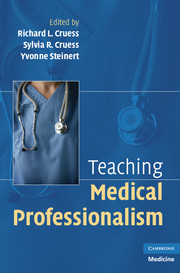Book contents
- Frontmatter
- Contents
- List of Contributors
- Foreword by William M. Sullivan
- Introduction
- PART ONE WHAT IS TO BE TAUGHT
- PART TWO THEORY
- PART THREE PRINCIPLES
- 4 Principles for Designing a Program for the Teaching and Learning of Professionalism at the Undergraduate Level
- 5 Resident Formation – A Journey to Authenticity: Designing a Residency Program That Educes Professionalism
- 6 Supporting Teaching and Learning of Professionalism – Changing the Educational Environment and Students' “Navigational Skills”
- 7 Assessment and Remediation in Programs of Teaching Professionalism
- 8 Developing Professionalism across the Generations
- 9 Faculty Development for Teaching and Learning Professionalism
- 10 The Relationship between Teaching Professionalism and Licensing and Accrediting Bodies
- 11 Educating the Public about Professionalism: From Rhetoric to Reality
- PART FOUR PRACTICE: CASE STUDIES IN TEACHING PROFESSIONALISM ACROSS THE CONTINUUM
- APPENDIX A Definitions of Professionalism
- APPENDIX B Core Attributes of Professionalism
- APPENDIX C The Teaching of Professionalism: Vignettes for Discussion
- APPENDIX D A Matrix for “Matching” Teaching Methods to Attributes
- APPENDIX E Sample Grid for Use with Discussion of Vignettes
- APPENDIX F Sample Questions to Guide Discussion about the Social Contract: Small-Group Leaders' Guide with Suggested Responses
- APPENDIX G Professionalism Program for Residents: Suggested Outline for Small Group Facilitators
- APPENDIX H Sample Evaluation Form for Residents' Half-Day Program on Professionalism
- Index
- References
6 - Supporting Teaching and Learning of Professionalism – Changing the Educational Environment and Students' “Navigational Skills”
Published online by Cambridge University Press: 01 September 2009
- Frontmatter
- Contents
- List of Contributors
- Foreword by William M. Sullivan
- Introduction
- PART ONE WHAT IS TO BE TAUGHT
- PART TWO THEORY
- PART THREE PRINCIPLES
- 4 Principles for Designing a Program for the Teaching and Learning of Professionalism at the Undergraduate Level
- 5 Resident Formation – A Journey to Authenticity: Designing a Residency Program That Educes Professionalism
- 6 Supporting Teaching and Learning of Professionalism – Changing the Educational Environment and Students' “Navigational Skills”
- 7 Assessment and Remediation in Programs of Teaching Professionalism
- 8 Developing Professionalism across the Generations
- 9 Faculty Development for Teaching and Learning Professionalism
- 10 The Relationship between Teaching Professionalism and Licensing and Accrediting Bodies
- 11 Educating the Public about Professionalism: From Rhetoric to Reality
- PART FOUR PRACTICE: CASE STUDIES IN TEACHING PROFESSIONALISM ACROSS THE CONTINUUM
- APPENDIX A Definitions of Professionalism
- APPENDIX B Core Attributes of Professionalism
- APPENDIX C The Teaching of Professionalism: Vignettes for Discussion
- APPENDIX D A Matrix for “Matching” Teaching Methods to Attributes
- APPENDIX E Sample Grid for Use with Discussion of Vignettes
- APPENDIX F Sample Questions to Guide Discussion about the Social Contract: Small-Group Leaders' Guide with Suggested Responses
- APPENDIX G Professionalism Program for Residents: Suggested Outline for Small Group Facilitators
- APPENDIX H Sample Evaluation Form for Residents' Half-Day Program on Professionalism
- Index
- References
Summary
Medical schools must insure that the learning environment for medical students promotes the development of explicit and appropriate professional attributes (attitudes, behaviors, and identity) in their medical students.
Liaison Committee on Medical Education, Standard MS-31-A: effective July 1, 2008Professionalism and professional standards in medicine are an active domain of discourse today. The reasons are many. Public concern over the sheer cost of medical care and the growth of un-insurance are daily news fare as are questions about patient safety and quality of care. Concern about how advances in biomedical science will be put to use are also visible.
The definition and meaningfulness of “professionalism” are also open for discussion. Sociologists have described professions as learned (highly knowledgeable) and self-regulating domains of work. Others have described professionalism as values-based domains of competency, or the moral core of medicine. Many approaches to education and training in professionalism are also apparent. Organizational and programmatic experimentation has been fueled by residency program requirements for education in professionalism endorsed by the Accreditation Council for Graduate Medical Education (ACGME), and explicit attention to this area of education by the National Board of Medical Examiners (NBME) and the Association of American Medical Colleges (AAMC). Some state associations of medical schools, for example, the Associated Medical Schools of New York, have seized the initiative and formed “learning networks” to pursue curriculum and organizational development in this domain.
In the explosion of literature focused on educating for professionalism, much expository text has been devoted to exploring the various qualities of “the good physician.”
- Type
- Chapter
- Information
- Teaching Medical Professionalism , pp. 108 - 123Publisher: Cambridge University PressPrint publication year: 2008
References
- 4
- Cited by

